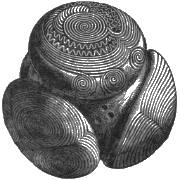Canmore Site 34535: CARLUNGIE - MONIKIE - SETTLEMENT (IRON AGE), SOUTERRAIN (PREHISTORIC), UNIDENTIFIED POTTERY (ROMAN)
Description
| Site Name | CARLUNGIE |
|---|---|
| Other Name(s) | CARLUNGIE I, CARLUNGIE EARTH HOUSE |
| Site Number | NO53NW 14 |
| Broad Class | UNASSIGNED (OBJECT), DOMESTIC |
| Site Type(s) | SETTLEMENT (IRON AGE), SOUTERRAIN (PREHISTORIC), UNIDENTIFIED POTTERY (ROMAN) |
| NGR | NO 51117 35972 |
| NGR accuracy | NGR given to the nearest 1m |
| Local Authority | ANGUS |
| Parish | MONIKIE |
| Record created | 1988-03-07 |
| Last updated | 2003-04-03 |
Archaeology Notes
NO53NW 14 5110 3597.
(NO 5110 3597) Souterrain (NR)
OS 6" map (1969)
A souterrain (Carlungie I) was associated settlement discovered on 17th October 1949 in the same field as Carlungie II (NO53SW 24) and excavated by Wainwright in the summers of 1950 and 1951.
The excavation showed that the trench for the souterrain was dug out and that the surface huts were built on the upcast.
The souterrain, one of the longest known, is 140' long and had four separate entrances. The paved passages average about 7' in width, the corbelled walls being of boulders and split flags. The surviving walling suggested an internal height of at least 6', and when the roofing slabs were in place they must have protruded above ground for 2' or more, eliminating the theory of concealment. The excavation suggested, and scientific analysis of the soil went some way to proving, that this had been a byre for cattle or sheep.
A contemporary settlement consisting of at least 8 huts was identified. Seven of the huts were built of boulders and opened onto a well-paved courtyard partly fenced by upright flags. The 8th hut appeared to be timber built, five post-holes being identified. The evidence suggested that the souterrain had been deliberately and carefully dismantled and filled up as soon as it went out of use, with no break in time nor any change of inhabitants. A cup-and-ring marked stone was found in the filling. A change also took place in the settlement, the courtyard and part of the souterrain being overlaid with paving, and a paved building 18' long and 12' wide, possibly a byre, being built over part of the settlement and another hut being built over two of the earlier ones.
The only dateable find was a Roman amphora, lying in fragments on the paved floor of one of the earlier huts, but the accumulated evidence suggests that the occupation fell between 50 AD and 450 AD and that the souterrain was demolished a little later than 200 AD but before 250 AD.
F T Wainwright 1953; 1963
A small wall-sherd of plain Samian ware collected as a surface find from Carlungie souterrain is now in Dundee Museum (Acc No 1987-186).
A Zealand 1988
NO 5135/5136 and NO 5034 A copper alloy ball with a hole pierced in one end, 3.5cm in diameter, was discovered in the vicinity of a souterrain in the Carlungie/Ardestie area, as a surface find. It was brought in as a verbal enquiry to Montrose Museum in 1994 and to Glasgow Museums in January 1995. It was retained by the finder. Glasgow Museums Enquiry Number 1306.
R Benvie 1995
Identifiers and Links to Other Records
This record has no links! Would you like to help?
| Identifier / External Link | Linked Record | Status | Comment |
|---|---|---|---|
| Canmore Site Number (legacy): NO53NW 14 | No linked record |
This area is visible only to logged in users.
